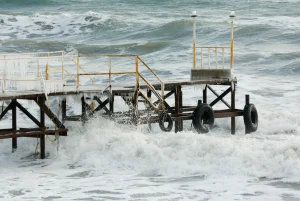Australia’s rapidly changing climate presents a growing challenge for small and medium-sized enterprises (SMEs). With increasing instances of bushfires, floods, and rising sea levels, it’s clear that businesses need to adapt to protect themselves against these threats. This guide explores how SMEs can safeguard their operations by addressing climate risks and leveraging business insurance as a critical component of their strategy.
Understanding Climate Risks for SMEs
The effects of climate change are no longer hypothetical—they are here. Rising temperatures, shifting rainfall patterns, and coastal threats are reshaping the operational landscape for SMEs across Australia.
Rising Temperatures and Their Impact

Since 2010, Australia has warmed by 1.51°C on land, with ocean temperatures increasing by 1.08°C since 1900. These changes are fuelling longer and more intense bushfire seasons. According to the CSIRO, the bushfire season has grown by 27 days over the last four decades, increasing the risk of property damage for businesses operating in vulnerable areas.
For SMEs such as cafés or farms in bushfire-prone zones, understanding these risks is crucial. Tools like the Climate Risk Map of Australia, provided by the Climate Council, can help you evaluate your exposure and take proactive measures.
Rainfall Extremes: A Double-Edged Sword

Australia’s rainfall patterns have become more unpredictable. Southern regions are experiencing drier conditions, putting pressure on urban water supplies and agricultural operations. Meanwhile, northern areas have seen a 20% increase in heavy rainfall since 1994, heightening flood risks.
Flooding not only disrupts supply chains but also damages infrastructure and natural ecosystems. For SMEs in agriculture, tourism, or coastal fisheries, these changes demand flexible solutions. Reviewing your business insurance policy to include flood coverage or crop loss protection is an essential step in safeguarding your livelihood.
Coastal Challenges: Rising Sea Levels and Marine Heatwaves

Sea levels in Australia have risen by 22 cm since 1900, and marine heatwaves are increasingly damaging coastal ecosystems and infrastructure. SMEs near the coast face unique challenges, including storm surges, erosion, and disrupted marine-based operations.
Tailored marine and coastal insurance options can provide essential protection against these risks. By customising your policy to address your business’s location and operations, you can mitigate potential losses and ensure peace of mind.
How Climate Change Impacts Business Insurance Premiums
The increasing frequency and severity of extreme weather events are driving up insurance premiums nationwide. Bushfires, floods, and other disasters have led to higher claim rates, which directly impact the cost of coverage for SMEs.
As your broker or adviser, we can help you navigate these rising costs by:
- Identifying potential gaps in your current coverage.
- Suggesting property protection measures that may lower your premiums.
- Recommending sustainable practices that diversify risk exposure and enhance resilience.
Practical Steps to Build Resilience
Building resilience to climate-driven threats requires a proactive approach. Here’s how SMEs can better prepare:
- Evaluate Risk Exposure
Use climate risk mapping tools to assess your property’s vulnerability to bushfires, floods, and sea level rise. - Secure Your Property
Reinforce structures, clear gutters, and use fire-resistant landscaping if you operate in bushfire-prone zones. - Leverage Government Grants
Tap into grants and tax incentives to invest in sustainable practices, such as energy-efficient equipment, solar panels, or water-saving technologies. - Develop a Continuity Plan
A business continuity plan protects both your physical and digital assets, ensuring faster recovery after an incident. - Diversify Supply Chains
Mitigate risks by working with multiple suppliers to reduce the impact of localised disruptions. - Partner with a Broker or Adviser
Collaborate with a professional to ensure your insurance coverage aligns with your unique risks and operational needs.
Why Business Insurance is Essential
While proactive measures help reduce risk, business insurance plays a vital role in covering the unexpected. Whether it’s bushfires, floods, or business interruption, having the right coverage ensures you’re financially prepared to recover and rebuild.
Specialised insurance options, such as property protection, flood coverage, and business interruption insurance, provide the safety net your SME needs to thrive in Australia’s changing climate.
The Role of Brokers and Advisers
Navigating the complexities of climate risks and insurance can be daunting. Partnering with an experienced broker or adviser makes it easier to identify the right solutions for your business. From reviewing your policies to tailoring coverage for specific risks, their expertise ensures you’re ready to face the future with confidence.
Take the First Step Today
Australia’s climate challenges are real, but with the right preparation and business insurance, your SME can weather the storm. Start by evaluating your risks, securing your property, and reaching out to a broker or adviser to ensure your insurance coverage is comprehensive and up-to-date.
By taking proactive steps now, you can safeguard your business and position it for resilience in 2025 and beyond.


